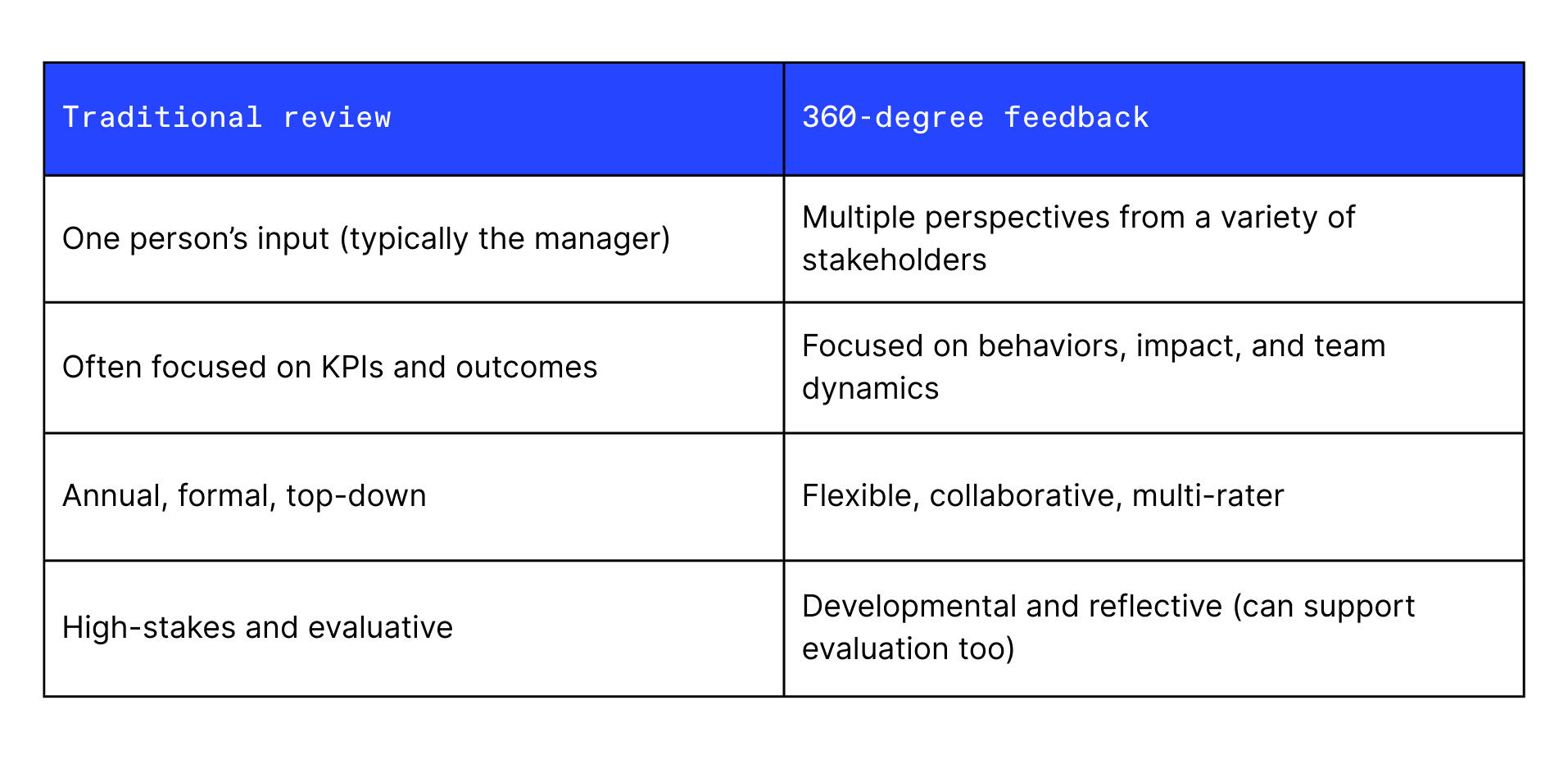360-degree feedback system explained: What it is, how it works, & how to get it right

%20(1).png)
If you’re an HR professional, people manager, or team lead, chances are you’ve encountered the term 360-degree feedback. It’s not new, but how organizations use it is evolving fast.
Once viewed as a niche tool for leadership development or performance remediation, 360-degree feedback has become a go-to method for creating a more comprehensive, transparent, and collaborative feedback culture. Especially in today’s hybrid work environments — where visibility can be limited and cross-functional collaboration is the norm — traditional manager-only reviews simply don’t tell the whole story.
Gone are the days of rigid, anonymous surveys used once a year for "development." Today’s 360-degree feedback processes are more human, flexible, and useful for both growth and performance.
When designed with care, they offer some of the richest insights you can gather about your team’s dynamics, contributions, and areas for growth. Whether you’re building a development plan, running a feedback program, or looking to improve employee performance metrics, 360s bring clarity.
What is 360-degree feedback?
360-degree feedback is a structured process for gathering feedback about an employee’s performance, skills, and behaviors from multiple perspectives — typically peers, managers, direct reports, and the employee themselves. Some companies also include customers, cross-functional collaborators, or external stakeholders.
The goal? To build a well-rounded, nuanced picture of how a person shows up at work. Not just what they do, but how they do it. This holistic review process helps identify competencies, professional development needs, and hidden strengths.
How it works in practice
- Feedback is requested to a group of selected reviewers (also called “raters”).
- The employee may be involved in choosing their feedback providers to ensure relevance.
- Everyone answers the same set of open-ended questions or structured prompts, often through a 360 degree feedback tool.
- The feedback assessments are compiled into a report and shared with the employee (usually with a manager or coach for support).
Depending on your company’s culture, this multi-source feedback can be anonymous, named, or a mix of both.
360-degree vs. traditional performance reviews

But here’s the key takeaway: 360-degree feedback isn’t just for personal development anymore. With the right questionnaire and mindset, it can contribute to performance reviews, leadership development initiatives, and employee evaluation processes.
Why 360-degree feedback matters in today’s workplace
Work has changed. Especially in hybrid and distributed environments, managers can’t observe every interaction, and impact often extends far beyond direct reports and traditional teams.
That’s where the 360-degree feedback process shines. It uncovers:
- Cross-functional competencies and team contributions
- Blind spots and gaps in perception vs. reality
- Opportunities for employee development that managers alone may miss
In essence, it creates a more complete employee evaluation and supports action plans that drive meaningful change. It also reinforces a culture of employee engagement, accountability, and continuous learning.
7 benefits of 360-degree feedback (with real-world context)
Implementing 360-degree feedback isn’t just about gathering opinions. It’s about unlocking deeper insights into how your people work, collaborate, and grow. When done right, this kind of multi-source feedback paints a fuller, fairer, and more actionable picture of an employee’s impact than any single data point ever could.
The benefits go far beyond personal development. From surfacing hidden strengths to helping managers coach more effectively, 360 feedback can drive real organizational impact — especially when it’s embedded into a culture that values transparency, growth, and shared accountability.
Here’s what your team can gain by making 360s part of your people strategy.
1. A fuller picture of employee impact
No single person has the full story. While managers may observe goal completion and direct outcomes, they often miss the everyday nuances of teamwork, support, and problem-solving. Peers, on the other hand, experience these moments firsthand. They see how colleagues contribute during high-pressure moments, show up in cross-functional projects, or help mentor others behind the scenes.
When you combine these varied perspectives, a richer narrative emerges. You begin to see patterns that go beyond KPIs: who steps up as a quiet leader, who builds bridges between teams, who helps maintain morale during change.
For example: a tech company introduced 360 reviews ahead of a company-wide reorg. One employee, a senior developer, consistently received recognition from peers for leading informal code reviews and onboarding support — two things not on their job description. That feedback helped justify a new team lead role that hadn’t been scoped in the original reorg plan.
2. Supports both development and performance
Historically, some teams used 360s for development only, not performance reviews. But that artificial divide is becoming less relevant. When the questions are intentionally structured and tied to business outcomes, 360 feedback becomes a meaningful input for both development and performance evaluation.
For example: a fast-growing startup introduced 360s to supplement their biannual reviews. While the manager’s review focused on goal metrics, peer feedback captured how employees contributed to team success, supported onboarding, or improved cross-team communication. That added color helped inform not just development plans, but also bonus and promotion discussions.
To ensure your 360-degree evaluation covers both development and performance, it’s important to ask the right questions for each.
- For performance related feedback, you can ask: “How does this person contribute to team objectives?”
- For personal development related feedback, you can ask: “What skill should they work on to level up their impact?”
It’s not about picking one lane. It’s about aligning feedback to your goals and giving a fuller picture of an employee’s contribution.
3. Encourages self-awareness and growth
One of the most transformative aspects of 360-degree feedback is the moment of realization it can spark. When employees compare their self-assessment to how others see them, they often uncover blind spots or receive unexpected validation. That contrast fosters reflection and drives more intentional behavior change.
For example: in a professional services firm, one consultant rated their own communication skills as average. However, peer feedback revealed they were consistently seen as a clear and calming communicator during high-pressure client calls. The outcome? Increased confidence and a pivot toward mentoring new hires in client communication.
This "aha" moment is often what makes 360s so powerful. It turns abstract concepts like "leadership presence" or "collaboration" into tangible areas to explore and improve.
4. Elevates peer recognition and accountability
Involving peers in the review process doesn’t just diversify feedback. It democratizes recognition. People want their contributions to be seen and appreciated, especially by those they work with most closely. And when feedback flows peer-to-peer, it strengthens accountability across the team.
For example: a mid-sized consulting firm used 360s to help embed a peer recognition culture during a period of rapid growth. Employees were asked to call out one teammate who made their job easier that quarter and why. The result? A more collaborative mindset and visible increase in knowledge-sharing across teams.
It’s no longer just about "my job". It’s about how we work together. And when people feel their peers value them, they’re more likely to bring their best selves to work.
5. Builds trust and transparency
By nature, 360-degree feedback also strengthens the foundation of a healthy feedback culture. By inviting input from multiple sources, the process signals that every voice matters and that feedback is a shared responsibility, not a top-down directive. It also encourages sharing and receiving feedback outside of performance management.
For example: A company implemented their first 360-degree review in their latest performance round. They noticed that following the performance appraisal, more employees felt comfortable sharing honest, constructive feedback with their colleagues AND the organization.
Especially in transparent, values-led cultures, employees feel empowered to speak up and speak truth. And that honesty is what fuels progress.
6. Gives managers better coaching inputs
Managers can’t coach what they don’t see. And in today’s distributed teams, they often miss the micro-moments that define how someone shows up at work. 360 feedback fills in those gaps and provides the kind of context-rich data that turns generic check-ins into personalized coaching sessions.
For example: a manufacturing company integrated 360 reviews into their quarterly leadership development track. Managers received anonymized peer feedback about team leads’ delegation, communication, and emotional intelligence. This helped leaders offer more tailored guidance and it gave high-potential employees clearer, more grounded goals.
360s provide actionable insights that help managers offer more targeted support and make better development decisions — not based on assumptions, but on collective, real-world input.
7. Aligns feedback to company values
Want to reinforce your culture? Make it part of how you evaluate success. By embedding core values into your 360 questions — like collaboration, curiosity, or accountability — you reinforce not just what gets done, but how it gets done.
At Workleap, for example, we built our 360 framework around our company values. Instead of asking generic questions, we ask behavioral prompts based on our core values. You can do the same by asking, “Which behavior(s) have you consistently embodied over the last two quarters? Select all that apply.” and listing out your values below.
If curiosity, collaboration, or ownership are your north stars, 360s are a great way to track how they show up in daily work and keep your culture alive in practice, not just posters.
Common concerns about 360-degree feedback and how to address them
360-degree feedback is powerful, but like any process involving people and emotions, it comes with potential friction points. These aren’t reasons to skip it altogether; they’re just signals that your implementation needs care, communication, and support.
The original criticisms of 360 feedback often centered around misuse: unclear objectives, vague questions, or teams lacking trust. But with modern tools and a thoughtful rollout, most of these challenges can be avoided, or even turned into learning moments.
Let’s look at a few of the common concerns teams raise, plus tips to address them without losing momentum.
1. “It creates anxiety or distrust”
Feedback can feel vulnerable, especially when it comes from multiple sources. Some employees may worry that 360 feedback could expose them to criticism they can’t respond to. This is especially true in organizations where feedback isn’t yet a cultural norm.
Solution: To reduce anxiety, be clear about the purpose of the process: it's about development and alignment, not punishment. Share examples of what helpful feedback looks like and normalize giving and receiving feedback in everyday interactions — long before the first formal review cycle.
2. “It’s biased or inaccurate”
Not all feedback is useful. Sometimes, reviewers may hold personal biases, feel pressure to be overly positive, or lack enough context to provide meaningful input. Especially in smaller or close-knit teams, there’s a risk that feedback becomes filtered through social dynamics rather than facts.
Solution: Start by training reviewers on what makes feedback effective: specificity, relevance, and fairness. Avoid vague prompts like "Is this person a good team player?" and focus on behavior-based questions. And always ensure reviewers have had recent, direct interaction with the person they're evaluating.
3. “It focuses too much on weaknesses”
Another common issue? Employees walking away from a 360 experience feeling deflated — especially if the feedback is framed entirely around what's missing or broken.
Solution: Use strengths-based prompts that spotlight what the person does well, in addition to areas for growth. Help managers interpret feedback constructively with their team members and reframe comments as opportunities. For instance, instead of "lacks leadership," consider "could benefit from more opportunities to lead cross-functional projects."
4. “It’s time-consuming"
From survey completion to feedback synthesis to debrief conversations, 360-degree feedback takes time. For managers already juggling meetings, deadlines, and team needs, it can feel like just another task.
Solution: Keep surveys short and purposeful. Use technology to streamline the process — automated reminders, templates, built-in reporting, and visual summaries can save hours. Start small by piloting with one team or role group, and scale once the process is smooth. When done right, the insights gained far outweigh the initial time investment.
When (and when not) to use 360-degree feedback
The 360-degree survey process can be used as a stand-alone employee feedback tool or as part of larger development programs. Used well, it supports both immediate initiatives and long-term culture change.
Use 360s when:
- You’re preparing someone for a promotion or leadership role
- You want to gather honest feedback before a performance review
- You’ve identified challenges with teamwork or cross-team collaboration
- You’re evaluating or evolving development programs
- You want to align performance data with company values and feedback from multiple respondents
Avoid 360s when:
- You don’t have the structure in place to support follow-up and coaching
- Feedback might feel punitive without a strong culture of effective feedback
- It’s the only type of feedback review happening (it should complement regular check-ins and performance evaluation touchpoints)
- The process isn’t aligned with clear goals or tied to any actionable outcomes
Sample 360 feedback questions
You don’t need a massive question bank. The best surveys are clear, simple, and tied to behaviors, not abstract traits.
Peer feedback questions
- What’s something this person consistently does that adds value to the team?
- How does this person handle feedback or conflict?
- How does their communication style impact collaboration?
- How well do they support or mentor others?
Manager feedback questions
- In what ways has this person contributed to the success of their team or department?
- What growth have you observed in this individual over the past quarter?
- What would help them take their performance to the next level?
Self-review questions
- What are you most proud of in the past six months?
- What’s one challenge you’ve encountered, and how did you handle it?
- What area do you want to grow in next—and what support would help?
Values-based prompts
If your company values include things like curiosity, collaboration, ownership, or impact, try these:
- How does this person embody [value] in their day-to-day work?
- What’s a recent moment where they lived this value?
Tips for launching 360-degree feedback in your org
If you’re looking to get started with 360 feedback, here are a few tips to keep in mind as you get started:
- Start with “why”: Set clear intentions: Are you using this for development? Promotion readiness? Team health checks? Be transparent with employees about what you’ll do with the feedback.
- Pilot, then scale: Run a small test with one team or leadership group. Collect feedback on the process, tweak your approach, and scale with confidence.
- Train your people: Feedback is a skill. Offer guidance (or even short training) on how to give clear, respectful, and helpful feedback. Don’t assume people know how.
- Keep it simple: Short surveys. Clear questions. Easy-to-understand reports. The simpler the process, the more likely people are to engage.
- Follow through: Don’t let the report sit in a drawer. Use it as a springboard for coaching conversations, goal setting, or professional development plans.
Final thoughts: Rethinking feedback, one perspective at a time
360-degree feedback isn’t a checkbox exercise. It’s a powerful opportunity to see your people more fully through the eyes of those they work with every day.
When embedded into your culture with intention, it helps employees grow, helps managers lead, and helps organizations build more connected, aligned, and high-performing teams.
In a world where hybrid work is the norm and collaboration crosses every boundary, 360 feedback just makes sense.
Want to learn how Workleap helps you make feedback a habit — not a headache?
Workleap Performance empowers real-time feedback, seamless 360 reviews, and actionable insights — all tailored for hybrid teams.
%20(1).png)

%20(1).avif)


.avif)
.avif)








